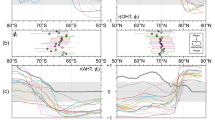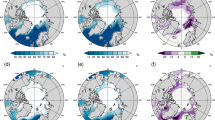Abstract
We investigate the causes for a strong high latitude imposed ice (land or sea) influence on the marine Intertropical Convergence Zone (ITCZ) in the Community Climate Model version 3 coupled to a 50-m slab ocean. The marine ITCZ in all the ocean basins shift meridionally away from the hemisphere with an imposed added ice cover, altering the global Hadley circulation with an increased tropical subsidence in the hemisphere with imposed ice and uplift in the other. The effect appears to be independent of the longitudinal position of imposed ice. The anomalous ice induces a rapid cooling and drying of the air and surface over the entire high- and midlatitudes; subsequent progression of cold anomalies occurs in the Pacific and Atlantic northeasterly trade regions, where a wind-evaporation-sea surface temperature (SST) feedback initiates progression of a cold SST ‘front’ towards the ITCZ latitudes. Once the cooler SST reaches the ITCZ latitude, the ITCZ shifts southwards, aided by positive feedbacks associated with the displacement. The ITCZ displacement transports moisture away from the colder and drier hemisphere into the other hemisphere, resulting in a pronounced hemispheric asymmetric response in anomalous specific humidity; we speculate that the atmospheric humidity plays a central role in the hemispheric asymmetric nature of the climate response to high latitude ice cover anomalies. From an energy balance viewpoint, the increased outgoing radiative flux at the latitudes of the imposed ice is compensated by an increased radiative energy flux at the tropical latitudes occupied by the displaced ITCZ, and subsequently transported by the altered Hadley and eddy circulations to the imposed ice latitudes. The situation investigated here may be applicable to past climates like the Last Glacial Maximum where hemispheric asymmetric changes to ice cover occurred. Major caveats to the conclusions drawn include omission of interactive sea ice physics and ocean dynamical feedback and sensitivity to atmospheric physics parameterizations across different models.












Similar content being viewed by others
References
Baker PA, Rigsby CA, Seltzer GO, Fritz SC, Lowenstein TK, Bacher NP, Veliz C (2001) Tropical climate changes at millennial and orbital timescales on the Bolivian Altiplano. Nature 409:698–701
Battisti DS (1988) Dynamics and thermodynamics of a warming event in a coupled tropical atmosphere ocean model. J Atmos Sci 45:2889–2919
Broccoli AJ (2000) Tropical cooling at the last glacial maximum: An atmosphere- mixed layer ocean model simulation. J Climate 13:951–976
Chang P, Ji L, Li H (1997) A decadal climate variation in the tropical Atlantic Ocean from thermodynamic air-sea interactions. Nature 385:516–518
Chiang JCH, Kushnir Y, Giannini A (2002) Deconstructing Atlantic ITCZ variability: Influence of the local cross-equatorial SST gradient, and remote forcing from the eastern equatorial Pacific. J Geophys Res 107. 10.1029/2000JD000307
Chiang JCH, Biasutti M, Battisti DS (2003) Sensitivity of the Atlantic ITCZ to conditions during Last Glacial Maximum. Paleoceanography (in press)
Denton GH, Hendy CH (1994) Younger Dryas Age Advance of Franz-Josef Glacier in the Southern Alps of New-Zealand. Science 264:1434–1437
Deser C, Magnusdottir G, Saravanan R, Phillips A (2004) The effects of North Atlantic SST and sea ice anomalies on the winter circulation in CCM3. Part II: direct and indirect components of the response. J Climate 17:877–889
Dong BW, Sutton RT (2002) Adjustment of the coupled ocean-atmosphere system to a sudden change in the Thermohaline circulation. Geophys Res Lett 29:art. no.-1728
Flohn H (1981) A hemispheric circulation asymmetry during late tertiary. Geologische Rundschau 70:725–736
Hastenrath S, Heller L (1977) Dynamics of climatic hazards in Northeast Brazil. Q J R Meteor Soc 103:77–92
Haug GH, Hughen KA, Sigman DM, Peterson LC and Rohl U (2001) Southward migration of the intertropical convergence zone through the Holocene. Science 293:1304–1308
Hughen KA, Overpeck JT, Peterson LC, Trumbore S (1996) Rapid climate changes in the tropical Atlantic region during the last deglaciation. Nature 380:51–54
Hughen KA, Southon JR, Lehman SJ, Overpeck JT (2000) Synchronous radiocarbon and climate shifts during the last deglaciation. Science 290:1951–1954
Joussaume S, Taylor KE (2000) The Paleoclimate Modeling Intercomparison Project. In: Proceedings of the third PMIP workshop, WCRP report 111:271
Kalnay E, Kanamitsu M, Kistler R, Collins W, Deaven D, Gandin L, Iredell M, Saha S, White G, Woollen J, Zhu Y, Chelliah M, Ebisuzaki W, Higgins W, Janowiak J, Mo KC, Ropelewski C, Wang J, Leetmaa A, Reynolds R, Jenne R, Joseph D (1996) The NCEP/NCAR 40-year reanalysis project. Bull Am Meteorol Soc 77:437–471
Kennett JP, Ingram BL (1995) A 20,000 year record of ocean circulation and climate-change from the Santa-Barbara Basin. Nature 377:510–514
Kiehl JT, Hack JJ, Bonan GB, Boville BA, Briegleb BP, Williamson DL, Rasch PJ (1996) Description of the NCAR community climate model. NCAR Technical Note TN-420+SR, pp 119–121
Kiehl JT, Hack JJ, Bonan GB, Boville BA, Williamson DL, Rasch PJ (1998) The National Center for Atmospheric Research Community Climate Model: CCM3. J Climate 11:1131–1149
Lea DW, Pak DK, Peterson LC, Hughen KA (2003) Synchroneity of tropical and high-latitude Atlantic temperatures over the last glacial termination. Science 301:1361–1364
Lynch-Stieglitz J (2004) Hemispheric asynchrony of abrupt climate change. Science 304:1919–1920
Manabe S, Broccoli AJ (1985) The influence of continental ice sheets on the climate of an ice-age. J Geophys Res Atmos 90:2167–2190
Nobre P, Shukla J (1996) Variations of sea surface temperature, wind stress, and rainfall over the tropical Atlantic and South America. J Clim 9:2464–2479
Peltier WR (1994) Ice-age paleotopography. Science 265:195–201
Peterson LC, Haug GH, Hughen KA, Rohl U (2000) Rapid changes in the hydrologic cycle of the tropical Atlantic during the last glacial. Science 290:1947–1951
Philander SGH, Gu D, Halpern D, Lambert G, Lau NC, Li T, Pacanowski RC (1996) Why the ITCZ is mostly north of the equator. J Climate 9:2958–2972
Rotstayn LD, Lohmann U (2002) Tropical rainfall trends and the indirect aerosol effect. J Climate 15:2103–2116
Schneider EK (1977) Axially-symmetric steady-state models of basic state for instability and climate studies. 2. Nonlinear calculations. J Atmos Sci 34:280–296
Schneider EK, Lindzen RS, Kirtman BP (1997) A tropical influence on global climate. J Atmos Sci 54:1349–1358
Schulz H, von Rad U, Erlenkeuser H (1998) Correlation between Arabian Sea and Greenland climate oscillations of the past 110,000 years. Nature 393:54–57
Stouffer RJ, Manabe S, Bryan K (1989) Interhemispheric asymmetry in climate response to a gradual increase of atmospheric CO2. Nature 342: 660–662
Stuiver M, Grootes PM (2000) GISP2 oxygen isotope ratios. Q Res 53: 277–283
Tomas RA, Holton JR, Webster PJ (1999) The influence of cross-equatorial pressure gradients on the location of near-equatorial convection. Q J Roy Meteor Soc 125:1107–1127
Trenberth KE, Stepaniak DP (2003) Seamless poleward atmospheric energy transports and implications for the Hadley circulation. J Clim 16: 3706–3722
Vellinga M, Wood RA (2002) Global climatic impacts of a collapse of the Atlantic thermohaline circulation. Clim Change 54:251–267
Wang CZ, Enfield DB (2003) A further study of the tropical Western Hemisphere warm pool. J Clim 16:1476–1493
Williams KD, Jones A, Roberts DL, Senior CA, Woodage MJ (2001) The response of the climate system to the indirect effects of anthropogenic sulfate aerosol. Clim Dynam 17:845–856
Xie S-P (1999) A dynamic ocean-atmosphere model of the tropical Atalantic decadal variability. J Clim 12:64–70
Xie SP, Philander SGH (1994) A Coupled Ocean-Atmosphere Model of Relevance to the Itcz in the Eastern Pacific. Tellus Ser A Dyn Meteorol Oceanol 46:340–350
Xie SP, Saito K (2001) Formation and variability of a northerly ITCZ in a hybrid coupled AGCM:Continental forcing and oceanic-atmospheric feedback. J Clim 14:1262–1276
Yang JY (1999) A linkage between decadal climate variations in the Labrador Sea and the tropical Atlantic Ocean. Geophys Res Lett 26: 1023–1026
Yin JH, Battisti DS (2001) The importance of tropical sea surface temperature patterns in simulations of last glacial maximum climate. J Clim 14:565–581
Yuan XJ, Martinson DG (2000) Antarctic sea ice extent variability and its global connectivity. J Clim 13:1697–1717
Acknowledgements
The idea to examine global climatic impacts of sea ice anomalies was first suggested to us by David Battisti, and we thank Camille Li and Andrew Friedman for their useful discussions. The model integrations were done on the IBM-SP maintained by the scientific computing division at National Center for Atmospheric Research (NCAR), and some of the analysis of the model output was done using the AMWG diagnostics package developed at NCAR. CMB gratefully acknowledges the support of the National Science Foundation (NSF) through grant AM0304662, and JCHC through NSF grant ATM-0438201.
Author information
Authors and Affiliations
Corresponding author
Rights and permissions
About this article
Cite this article
Chiang, J.C.H., Bitz, C.M. Influence of high latitude ice cover on the marine Intertropical Convergence Zone. Climate Dynamics 25, 477–496 (2005). https://doi.org/10.1007/s00382-005-0040-5
Received:
Accepted:
Published:
Issue Date:
DOI: https://doi.org/10.1007/s00382-005-0040-5




